Developer Guide
- Setting up, getting started
- Design
- Implementation
- Current bugs and feature ideas
- Documentation, logging, testing, configuration, dev-ops
- Appendix: Requirements
-
Appendix: Instructions for manual testing
- Launch and shutdown
- Listing all contacts and modules
- Listing all contacts
- Listing all modules
- Switching the active semester
- Resetting data
- Clearing all contacts from the contact list
- Clearing all modules from the module list
- Help
- Exiting the program
- Saving data
- Adding a contact
- Deleting a contact
- Editing a contact
- Adding or editing a remark
- Finding contacts by attributes
- Adding a module
- Deleting a module
- Finding modules
- Assigning a contact to one or more modules
- Unassigning a contact from one or more modules
- Unassigning all contacts
- Appendix: Effort
Setting up, getting started
Refer to the guide Setting up and getting started.
Design
Architecture

The Architecture Diagram given above explains the high-level design of the App. Given below is a quick overview of each component.
.puml files used to create diagrams in this document can be found in the diagrams folder. Refer to the PlantUML Tutorial at se-edu/guides to learn how to create and edit diagrams.
Main has two classes called Main and MainApp. It is responsible for,
- At app launch: Initializes the components in the correct sequence, and connects them up with each other.
- At shut down: Shuts down the components and invokes cleanup methods where necessary.
Commons represents a collection of classes used by multiple other components.
The rest of the App consists of four components.
-
UI: The UI of the App. -
Logic: The command executor. -
Model: Holds the data of the App in memory. -
Storage: Reads data from, and writes data to, the hard disk.
Each of the four components,
- defines its API in an
interfacewith the same name as the Component. - exposes its functionality using a concrete
{Component Name}Managerclass (which implements the corresponding APIinterfacementioned in the previous point.
For example, the Logic component (see the class diagram given below) defines its API in the Logic.java interface and exposes its functionality using the LogicManager.java class which implements the Logic interface.

How the architecture components interact with each other
The Sequence Diagram below shows how the components interact with each other for the scenario where the user issues the command delete 1.

The sections below give more details of each component.
UI component

API :
Ui.java
The UI consists of a MainWindow that is made up of parts e.g.CommandBox, ResultDisplay, PersonListPanel, StatusBarFooter etc. All these, including the MainWindow, inherit from the abstract UiPart class.
The UI component uses JavaFx UI framework. The layout of these UI parts are defined in matching .fxml files that are in the src/main/resources/view folder. For example, the layout of the MainWindow is specified in MainWindow.fxml
The UI component,
- Executes user commands using the
Logiccomponent. - Listens for changes to
Modeldata so that the UI can be updated with the modified data.
Logic component

API :
Logic.java
-
Logicuses theAddressBookParserclass to parse the user command. - This results in a
Commandobject which is executed by theLogicManager. - The command execution can affect the
Model(e.g. adding a contact). - The result of the command execution is encapsulated as a
CommandResultobject which is passed back to theUi. - In addition, the
CommandResultobject can also instruct theUito perform certain actions, such as displaying help to the user.
Given below is the Sequence Diagram for interactions within the Logic component for the execute("delete 1") API call.

DeleteCommandParser should end at the destroy marker (X) but due to a limitation of PlantUML, the lifeline reaches the end of diagram.
Model component

API : Model.java
The Model,
- stores a
UserPrefobject that represents the user’s preferences. - stores FaculType data.
- exposes an unmodifiable
ObservableList<Person>andObservableList<Module>that can be ‘observed’ e.g. the UI can be bound to this list so that the UI automatically updates when the data in the list change. - does not depend on any of the other three components.
Tag list in the AddressBook, which Person references. This allows AddressBook to only require one Tag object per unique Tag, instead of each Person needing their own Tag object.
Storage component

API : Storage.java
The Storage component,
- can save
UserPrefobjects in json format and read it back. - can save FaculType data in json format and read it back.
Common classes
Classes used by multiple components are in the seedu.addressbook.commons package.
Implementation
This section describes some noteworthy details on how certain features are implemented.
Find contacts by attributes feature
Implementation
The find mechanism is facilitated by FindCommand and FindCommandParser. It allows users to search for contacts by
their respective attributes. It uses ModelManager#updateFilteredPersonList(Predicate p) which is
exposed in the Model interface as Model#updateFilteredList(Predicate p). The method updates the
current person list and filters it according to the given predicate which will then be shown accordingly in the GUI.
The following sequence diagram shows how the find by attributes operation works:
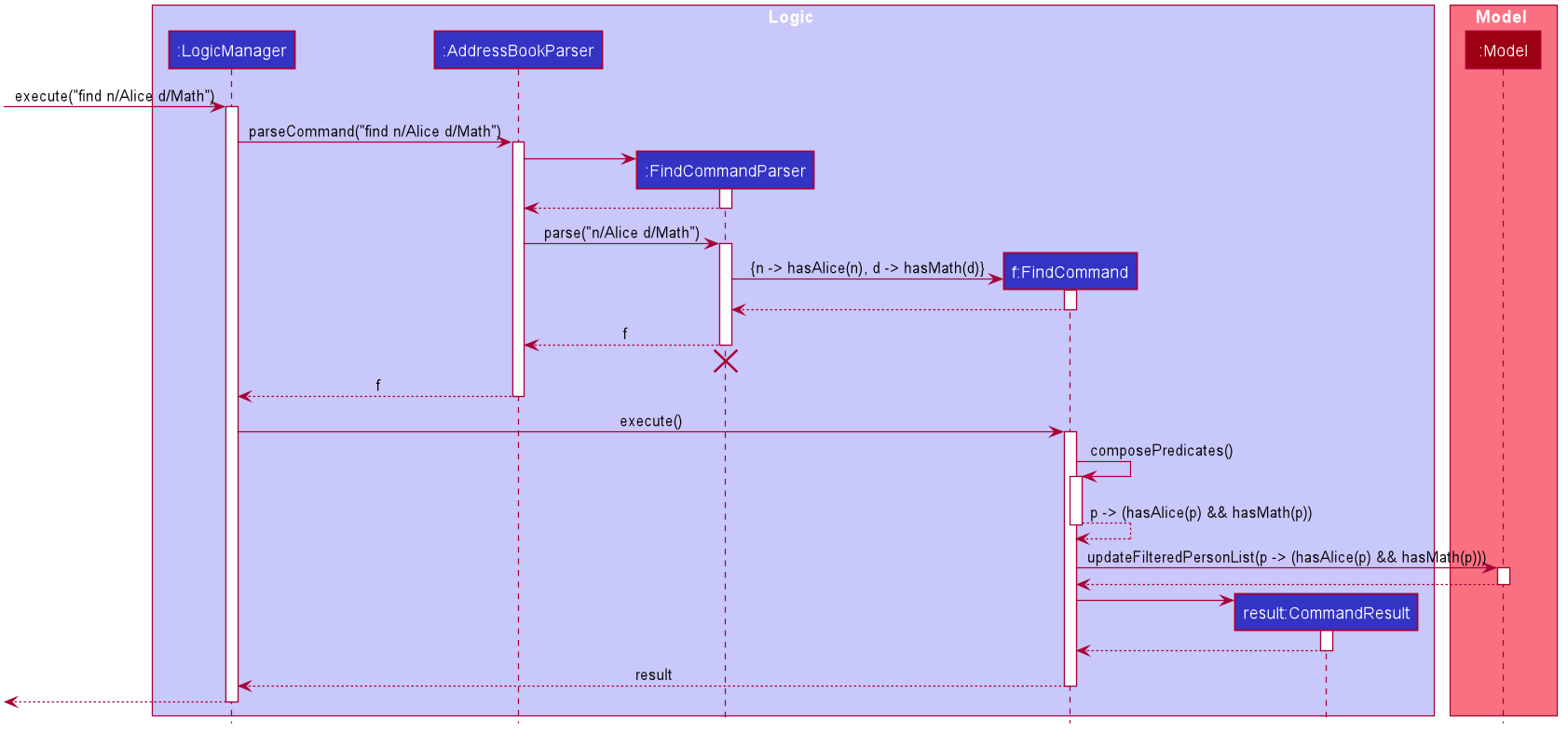
FindCommandParser should
end at the destroy marker (X) but due to a limitation of PlantUML, the lifeline reaches the end of diagram.
The following activity diagram summarizes what happens when a user executes a find command:

Design consideration:
Aspect: How find executes
-
Alternative 1 (current choice): AND Searching from multiple attributes and keywords.
- Pros: Provides the ability to narrow down search results by adding more keywords and attributes.
- Cons: Unable to search for multiple persons with different attributes.
-
Alternative 2: AND Searching across attributes, OR Searching between keywords.
- Pros: Provides the ability to narrow down search results by adding more attributes as well as expanding the search scope by adding more keywords (i.e: more flexible).
- Cons: A possible source of confusion as they use different searching methods.
Both options are equally feasible. However, Alternative 1 was chosen to avoid confusion for prospective users.
Find modules by attributes feature
Implementation
The find module mechanism is facilitated by FindModCommand and FindModCommandParser. It allows users to search for modules based on their respective attributes which are the module code, module name and instructors of the module.
It uses ModelManager#updateFilteredModuleList(Predicate p) which is exposed in the Model interface as Model#updateFilteredModuleList(Predicate p).
The method updates the active semester module list and filters it according to the given predicate which will then be reflected accordingly in the GUI.
The following sequence diagram shows how the find module by module attributes operation works:

FindModCommandParser should
end at the destroy marker (X) but due to a limitation of PlantUML, the lifeline reaches the end of diagram.
The following activity diagram summarizes what happens when a user executes a findmod command:

Design consideration:
Aspect: How findmod executes
-
Alternative 1 (current choice): AND searching from multiple attributes and AND searching between keywords for module name and instructor attributes. Module code attribute only allows single keywords.
- Pros : Provides the ability to narrow down the search results by adding more attributes and keywords. Single keyword for module code attribute allows for more focused module code searches.
- Cons : Unable to have a more general search and unable to search for multiple modules with different module codes.
-
Alternative 2: And searching across attributes and OR searching between keywords for module name and instructor attributes.
- Pros : Provides the ability for a very general and flexible search.
- Cons : Unable to have a more focused search, might be more confusing for the user to narrow down his/her searches.
Delete modules feature
Implementation
The delete module mechanism is facilitated by the DelmodCommand and the DelmodCommandParser.
It uses an operation AddressBook#removeModule() which is exposed in the Model interface as Model#deleteModule().
Then, the removeModuleWithCode() operation is called in the active semester UniqueModuleList. UniqueModuleList#removeModuleWithCode() will remove the module with the specified code
from the module list.
Given below is the example usage scenario and how the delete module mechanism behaves at each step.
-
The user launches the application. FaculType has the module
CS2103in the active semester. -
The user executes the command
delmod m/CS2103to delete the module with the module codeCS2103. -
The
DelmodCommandthen callsModel#deleteModule()after checking for the existence of the specified module. -
The module with the specified module code will be deleted from the active semester
UniqueModuleListinAddressBook.
The following sequence diagram shows how the deleting of the module works:
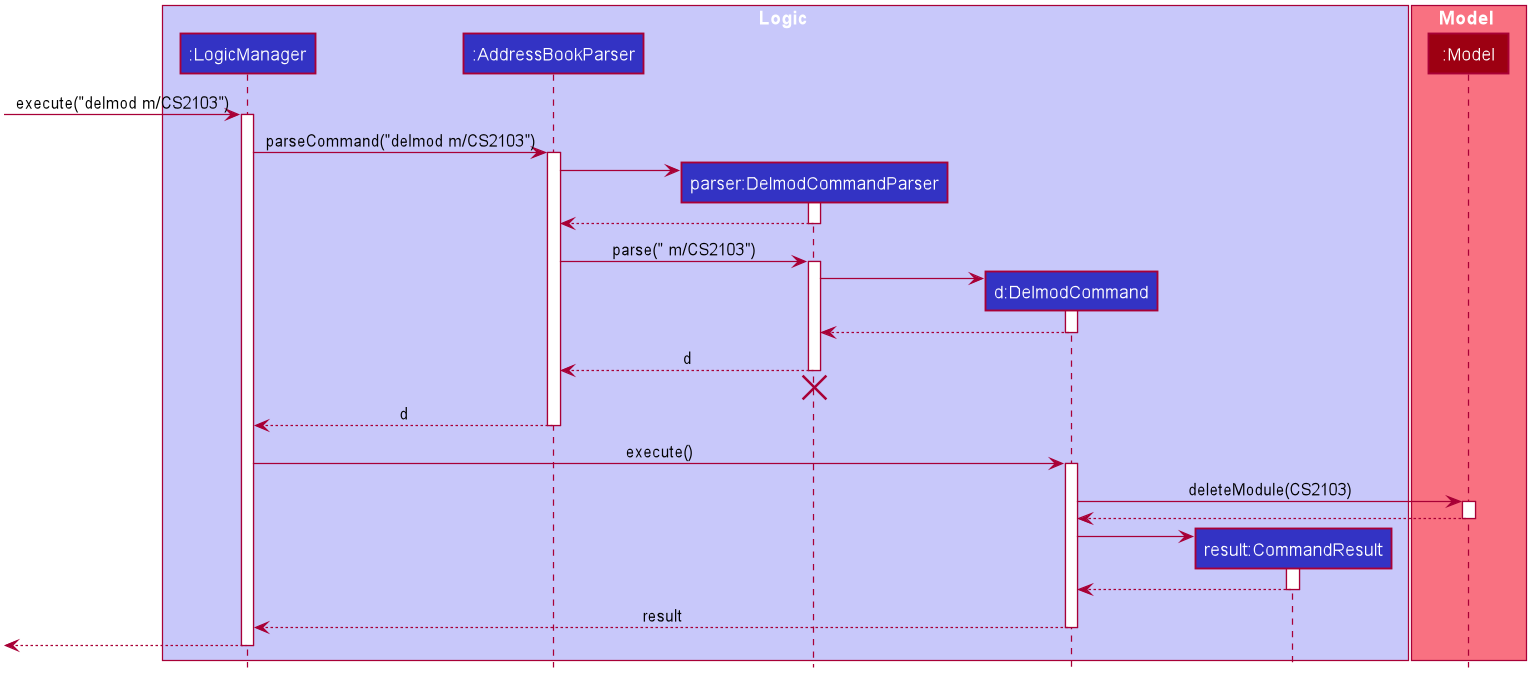
DelmodCommandParser should
end at the destroy marker (X) but due to a limitation of PlantUML, the lifeline reaches the end of diagram.
The following activity diagram summarizes what happens when a user executes a delmod command:
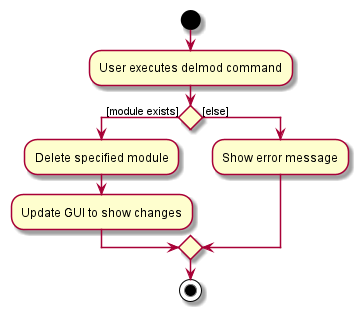
Design consideration:
Aspect: What the delmod command deletes by
-
Alternative 1 (current choice): Deletes a module based on the module code.
- Pros : More intuitive to the Dean to delete by the module code.
- Cons : Would be more troublesome to look for the module should the Dean forget the module code.
-
Alternative 2: Deletes a module based on the index of the module list.
- Pros : Dean does not have to memorise all the module code, can simply delete based on what is shown in the module list.
- Cons : Less intuitive.
Assign feature
Implementation
The assign feature is facilitated by AssignCommand and AssignCommandParser.
It uses an operation AddressBook#assignInstructor() which is exposed in the Model interface as Model#assignInstructor().
Then, the assignInstructor() operation is called in both UniqueModuleList and Module. Module#assignInstructor() will add the instructor to the module’s set of instructors.
The following sequence diagram shows how the assign operation works:
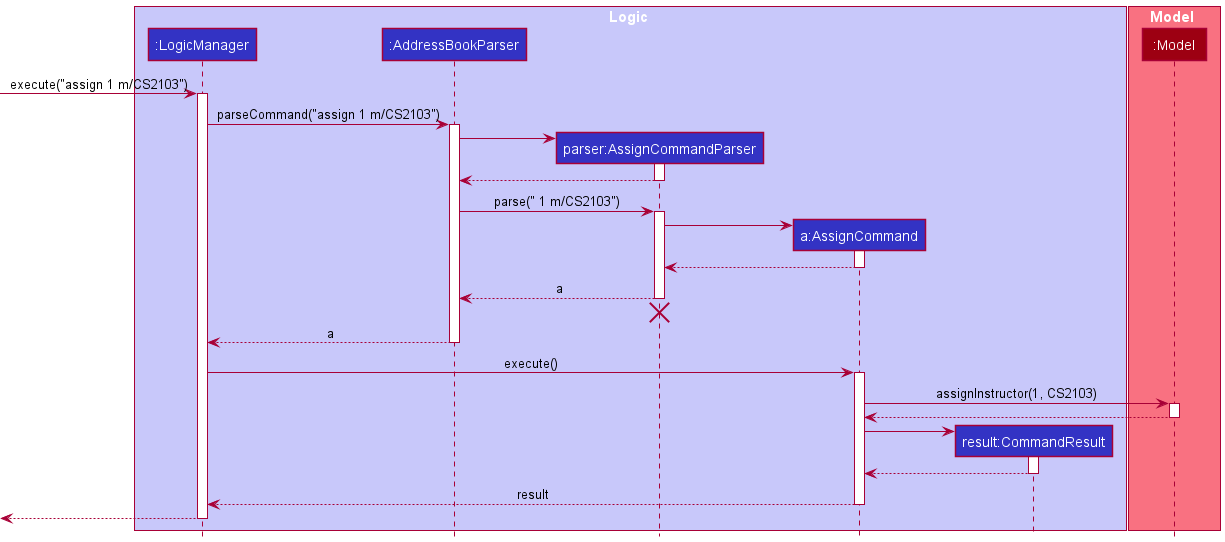
AssignCommandParser should
end at the destroy marker (X) but due to a limitation of PlantUML, the lifeline reaches the end of diagram.
The following activity diagram summarizes what happens when a user executes an assign command:

Design consideration:
Aspect: How to store assignments
-
Alternative 1 (current choice): A module has a set of instructors assigned to it.
- Pros: More efficient to list the instructors of a certain module.
- Cons: Less efficient to list the modules of a certain instructor.
-
Alternative 2: An instructor has a set of modules they are assigned to.
- Pros: More efficient to list the modules of a certain instructor.
- Cons: Less efficient to list the instructors of a certain module.
Both are equally viable options but Alternative 1 was chosen so Person would not have to be redesigned or have too many fields.
Unassign feature
The unassign feature is facilitated by UnassignCommand and UnassignCommandParser.
It uses an operation AddressBook#unassignInstructor() which is exposed in the Model interface as Model#unassignInstructor().
Then, the unassignInstructor() operation is called in both UniqueModuleList and Module. Module#unassignInstructor() will remove the instructor from the module’s set of instructors.
The following sequence diagram shows how the unassign operation works:
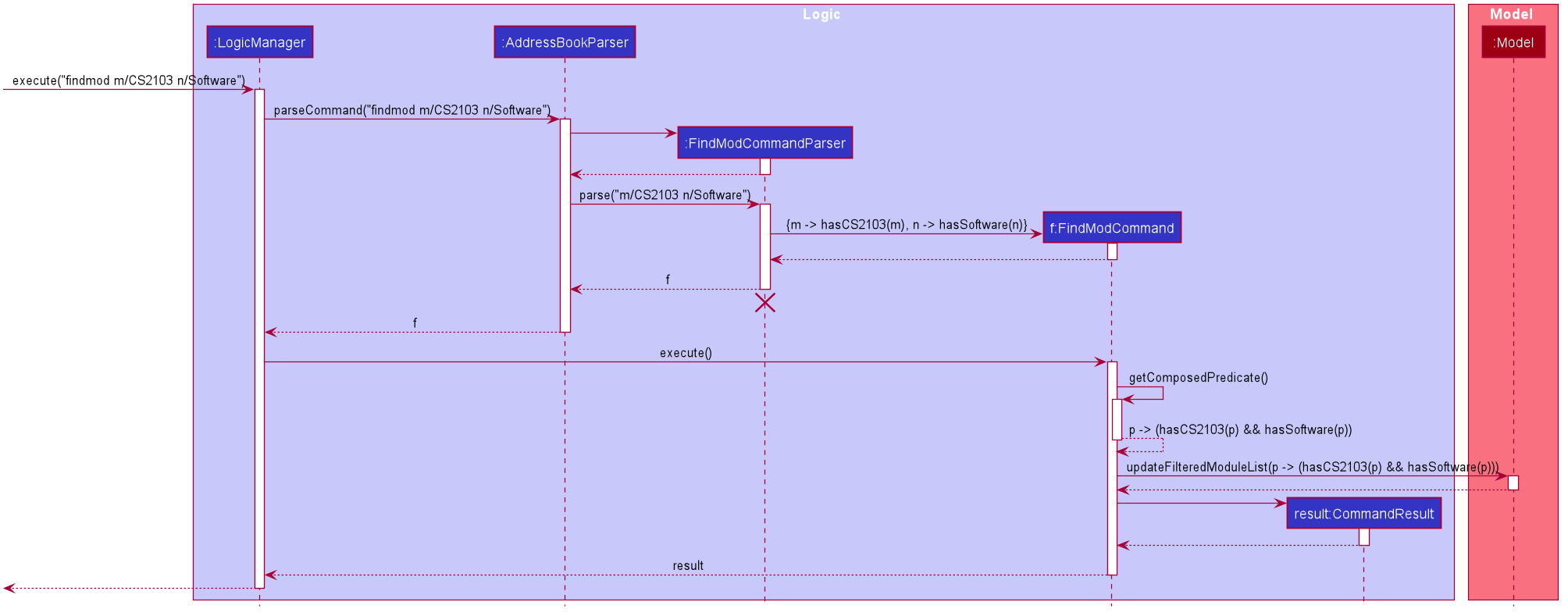
UnassignCommandParser should
end at the destroy marker (X) but due to a limitation of PlantUML, the lifeline reaches the end of diagram.
The following activity diagram summarizes what happens when a user executes an unassign command:

Unassignall feature
The unassignall feature is facilitated by UnassignallCommand and UnassignallCommandParser.
It uses an operation AddressBook#unassignAllInstructors() which is exposed in the Model interface as Model#unassignAllInstructors().
Then, the unassignAllInstructors() operation is called in both UniqueModuleList and Module. Module#unassignAllInstructors() will remove all instructors from all modules’ set of instructors.
The following sequence diagram shows how the unassignall operation works:
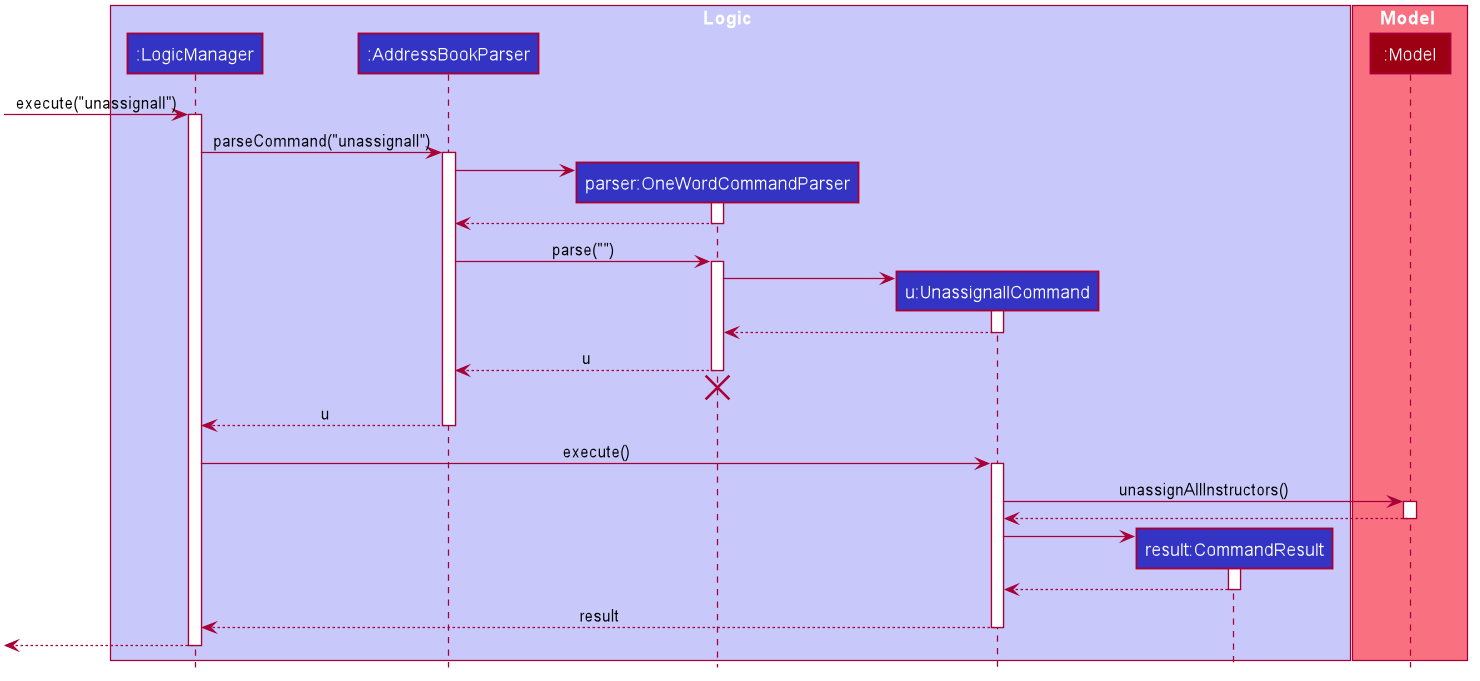
UnassignallCommandParser should
end at the destroy marker (X) but due to a limitation of PlantUML, the lifeline reaches the end of diagram.
The following activity diagram summarizes what happens when a user executes an unassignall command:
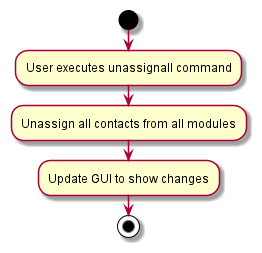
Design consideration:
Aspect: How unassignall executes
- Alternative 1 (current choice): Unassigns all instructors from all modules.
- Pros : More efficient to unassign all instructors from all modules.
-
Cons : Less efficient to unassign a certain instructor from all modules he/she instructs.
- Alternative 2: Unassign a certain instructor from all modules he/she instructs.
- Pros : More efficient to unassign a certain instructor from all modules he/she instructs.
- Cons : Less efficient to unassign all instructors from all modules.
Clear all contacts feature
Implementation
It implements the following operations:
-
AddressBook#clearContacts()— Clear all contacts from the contact list.
These operations are exposed in the Model interface as Model#clearContacts() and UniquePersonList class as UniquePersonList#clearAll()
The following sequence diagram shows how the cclear operation works:

OneWordCommandParser should
end at the destroy marker (X) but due to a limitation of PlantUML, the lifeline reaches the end of diagram.
The following activity diagram summarizes what happens when a user executes a cclear command:
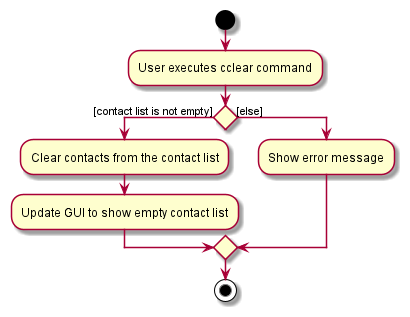
Clear all modules feature
Implementation
It implements the following operations:
-
AddressBook#clearMod()— Clear all modules from the active semester module list.
These operations are exposed in the Model interface as Model#clearMod() and UniqueModuleList class as UniqueModuleList#clearAll()
The following sequence diagram shows how the mclear operation works:
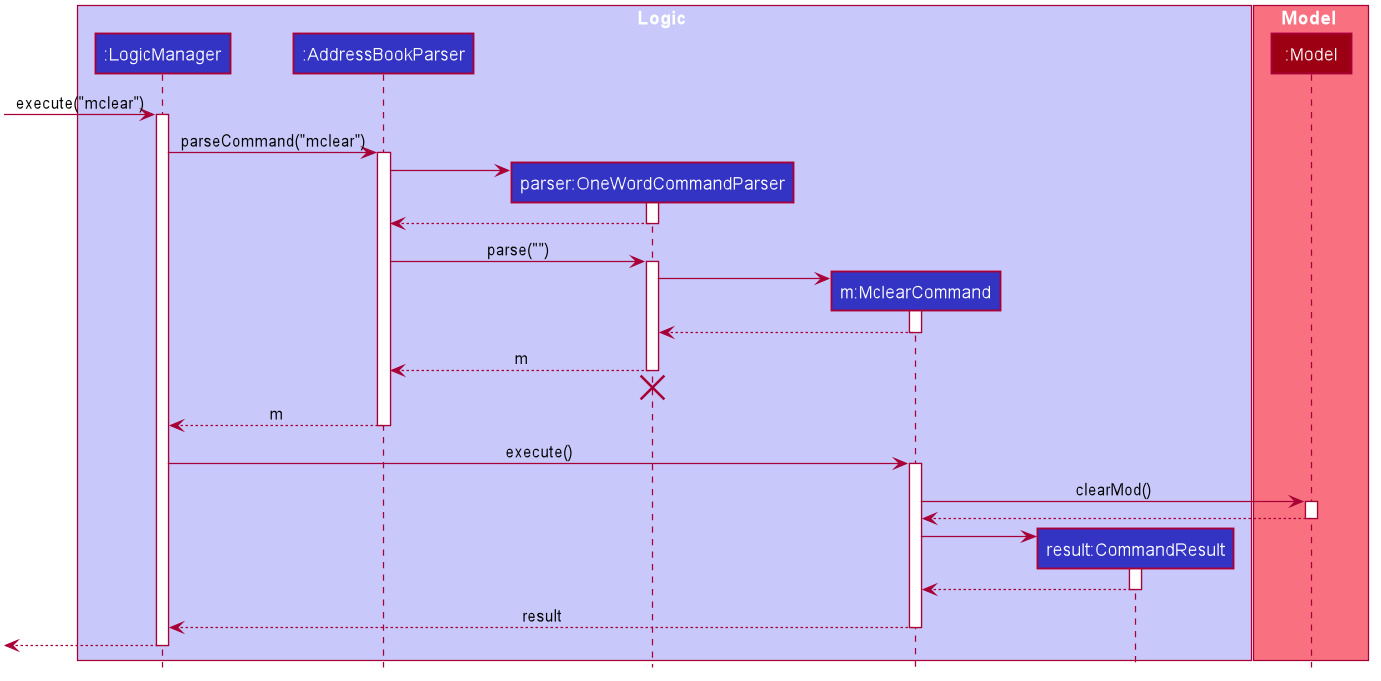
OneWordCommandParser should
end at the destroy marker (X) but due to a limitation of PlantUML, the lifeline reaches the end of diagram.
The following activity diagram summarizes what happens when a user executes a mclear command:
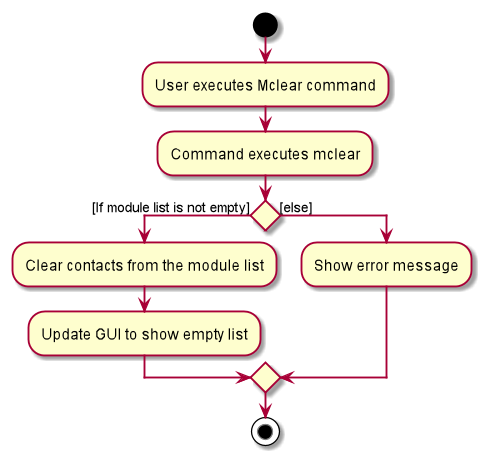
Switch active semester feature
Implementation
The switch feature is facilitated by AddressBook#switchModuleList() which is exposed in the Model interface as Model#switchModuleList().
AddressBook has two module lists, one for each semester, and one additional UniqueModuleList variable named activeModules that stores a reference to the active semester’s module list.
AddressBook#switchModuleList() toggles which module list is referenced by activeModules.
All AddressBook operations on UniqueModuleList are done on activeModules.
The following sequence diagram shows how the switch operation works:
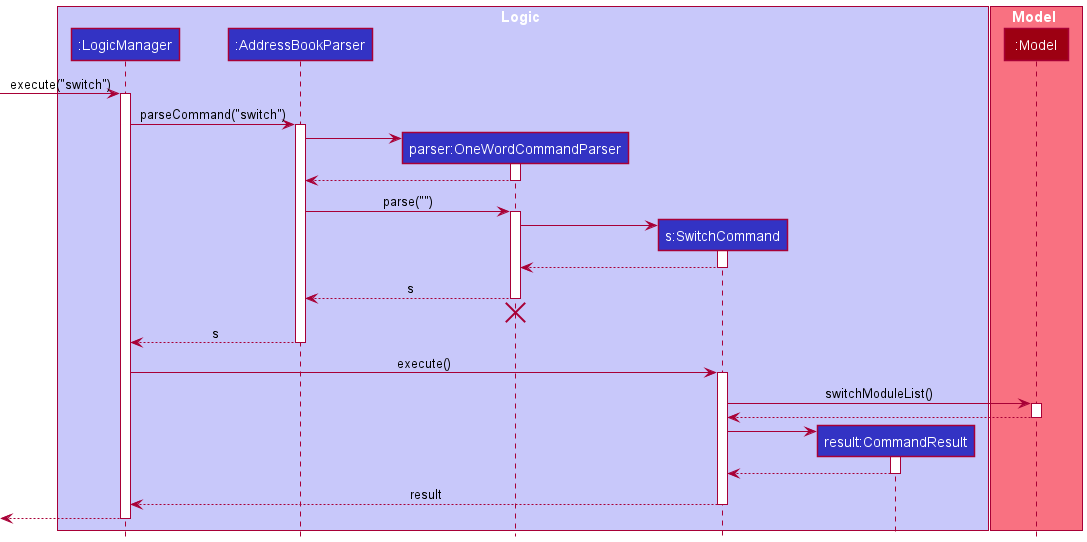
OneWordCommandParser should
end at the destroy marker (X) but due to a limitation of PlantUML, the lifeline reaches the end of diagram.
The following activity diagram summarizes what happens when a user executes a switch command:
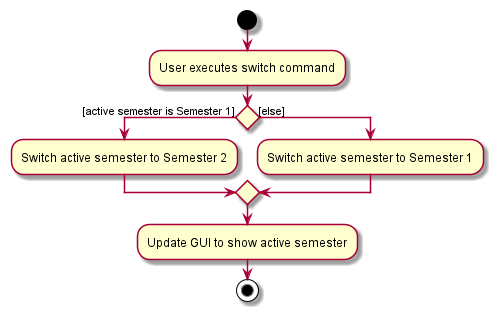
Design consideration:
Aspect: Setting the active semester
-
Alternative 1 (current choice): There are two module lists and active semester references one of them.
- Pros: Less code to change.
- Cons: Can only manage the modules in the active semester.
-
Alternative 2: There is only one module list and there is a filter to select modules of a particular semester.
- Pros: More efficient to list the modules of a certain instructor.
- Cons: Need to add semester field to modules and commands, will have two copies of the same module if held in both semesters, more code to change.
[Proposed] Undo/redo feature
Proposed Implementation
The proposed undo/redo mechanism is facilitated by VersionedAddressBook. It extends AddressBook with an undo/redo history, stored internally as an addressBookStateList and currentStatePointer. Additionally, it implements the following operations:
-
VersionedAddressBook#commit()— Saves the current FaculType state in its history. -
VersionedAddressBook#undo()— Restores the previous FaculType state from its history. -
VersionedAddressBook#redo()— Restores a previously undone FaculType state from its history.
These operations are exposed in the Model interface as Model#commitAddressBook(), Model#undoAddressBook() and Model#redoAddressBook() respectively.
Given below is an example usage scenario and how the undo/redo mechanism behaves at each step.
Step 1. The user launches the application for the first time. The VersionedAddressBook will be initialized with the initial FaculType state, and the currentStatePointer pointing to that single FaculType state.

Step 2. The user executes delete 5 command to delete the 5th contact in FaculType. The delete command calls
Model#commitAddressBook(), causing the modified state of FaculType after the delete 5 command executes to be saved in the addressBookStateList, and the currentStatePointer is shifted to the newly inserted FaculType state.

Step 3. The user executes add n/David … to add a new contact. The add command also calls Model#commitAddressBook
(), causing another modified FaculType state to be saved into the addressBookStateList.

Model#commitAddressBook(), so the FaculType state will not be saved into the addressBookStateList.
Step 4. The user now decides that adding the contact was a mistake, and decides to undo that action by executing the
undo command. The undo command will call Model#undoAddressBook(), which will shift the currentStatePointer once to the left, pointing it to the previous FaculType state, and restores FaculType to that state.

currentStatePointer is at index 0, pointing to the initial AddressBook state, then there are no previous AddressBook states to restore. The undo command uses Model#canUndoAddressBook() to check if this is the case. If so, it will return an error to the user rather
than attempting to perform the undo.
The following sequence diagram shows how the undo operation works:

UndoCommand should end at the destroy marker (X) but due to a limitation of PlantUML, the lifeline reaches the end of diagram.
The redo command does the opposite — it calls Model#redoAddressBook(), which shifts the currentStatePointer once to the right, pointing to the previously undone state, and restores FaculType to that state.
currentStatePointer is at index addressBookStateList.size() - 1, pointing to the latest FaculType state, then there are no undone AddressBook states to restore. The redo command uses Model#canRedoAddressBook() to check if this is the case. If so, it will return an error to the user rather than attempting to perform the redo.
Step 5. The user then decides to execute the command list. Commands that do not modify FaculType, such as list, will usually not call Model#commitAddressBook(), Model#undoAddressBook() or Model#redoAddressBook(). Thus, the addressBookStateList remains unchanged.

Step 6. The user executes clear, which calls Model#commitAddressBook(). Since the currentStatePointer is not pointing at the end of the addressBookStateList, all FaculType states after the currentStatePointer will be purged. Reason: It no longer makes sense to redo the add n/David … command. This is the behavior that most modern desktop applications follow.

The following activity diagram summarizes what happens when a user executes a new command:

Design consideration:
Aspect: How undo & redo executes
-
Alternative 1 (current choice): Saves the entire FaculType data.
- Pros: Easy to implement.
- Cons: May have performance issues in terms of memory usage.
-
Alternative 2: Individual command knows how to undo/redo by
itself.
- Pros: Will use less memory (e.g. for
delete, just save the contact being deleted). - Cons: We must ensure that the implementation of each individual command is correct.
- Pros: Will use less memory (e.g. for
Current bugs and feature ideas
This section describes bugs found in the current version of FaculType and feature ideas that have been proposed but currently don’t have implementation details yet. Both of which are to be fixed/implemented in the next version of FaculType.
Current bugs
- Editing a contact’s identifying attributes (name, phone, email) to be the same as another contact’s causes problems due to the detection of duplicate contacts. This bug is inherited from the parent project AddressBook Level 3.
- A tag in a contact card and an instructor tag in a module card may be cut off if the text inside is too long or if there are too many tags. This bug is inherited from the parent project AddressBook Level 3.
Example of the tag bug:
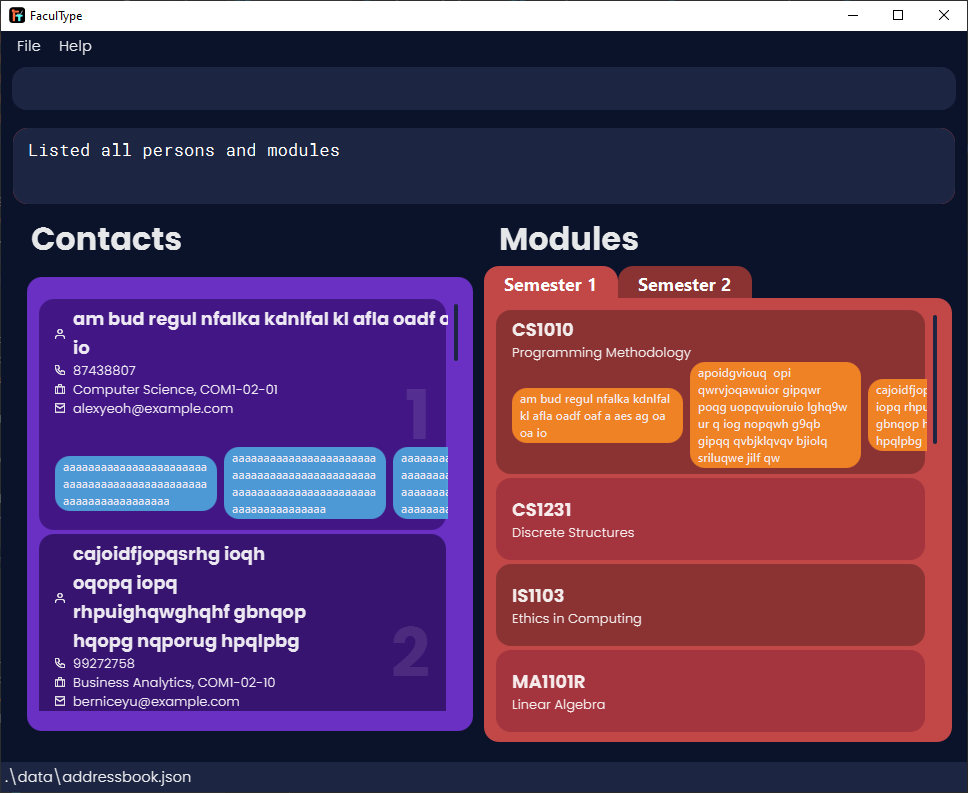
- No validation of instructor existence for modules. Adding a non-existent instructor by editing the
addressbook.jsonfile will not throw any error.
Example of the instructor bug:

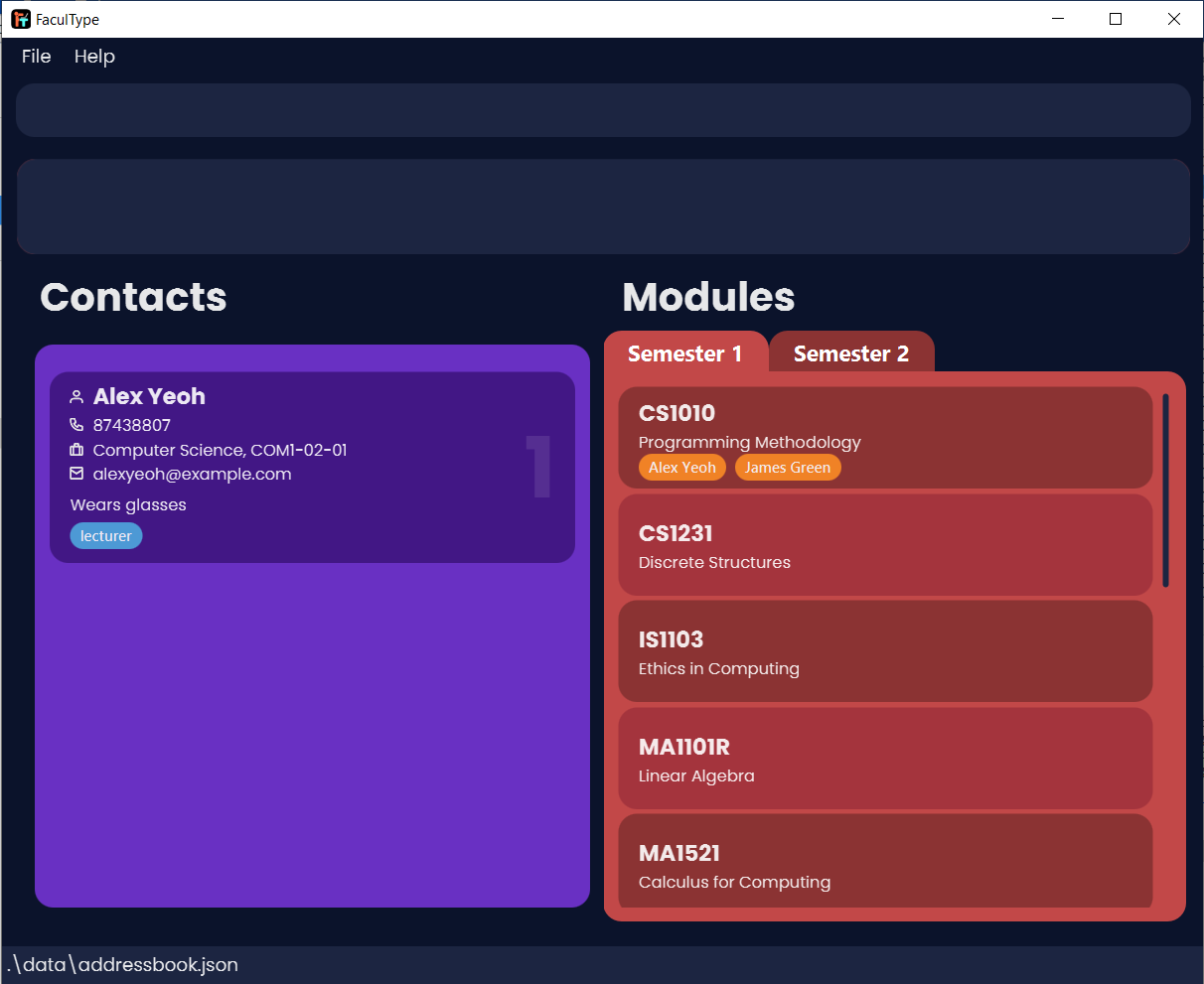
Feature ideas
- Order filter results of contacts and modules by how much they match the specified parameters (Coming soon).
- Differentiate instructor tags in module cards for instructors with the same name (Coming soon).
Documentation, logging, testing, configuration, dev-ops
Appendix: Requirements
Product scope
Target user profile:
- works as a faculty leader
- has a need to manage a significant number of faculty members
- has a need to manage a significant number of modules
- has a need to manage assignments of modules to faculty members
- prefer desktop apps over other types
- can type fast
- prefers typing to mouse interactions
- is reasonably comfortable using CLI apps
Value proposition: manage faculty members and modules faster than a typical mouse/GUI driven app
User stories
Priorities: High (must have) - * * *, Medium (nice to have) - * *, Low (unlikely to have) - *
| Priority | As a … | I want to … | So that I can… |
|---|---|---|---|
* * * |
new user | see usage instructions | refer to instructions when I forget how to use the App |
* * * |
user | add a new contact | |
* * * |
user | delete a contact | remove contacts that I no longer need |
| Priority | As a … | I want to … | So that I can… |
|---|---|---|---|
* * * |
user | find a contact by attributes | locate details of contacts without having to go through the entire list |
* * * |
forgetful user | add remarks to contacts | remember certain details about them |
* * * |
faculty leader | store a contact’s office | keep track of where to find them |
* * * |
faculty leader | store a contact’s department | keep track of their respective field |
* * * |
faculty leader | edit a contact’s office | keep the contact data up to date |
* * * |
faculty leader | edit a contact’s department | keep the contact data up to date |
* * * |
faculty leader | add a new module | |
* * * |
faculty leader | delete a module | remove modules no longer offered |
* * * |
faculty leader | find modules by attributes | locate modules without having to go through the entire list |
* * * |
faculty leader | find modules by the instructor’s name | locate modules instructed by the instructor |
* * * |
faculty leader | assign a contact to various modules | keep track of the modules they instruct |
| Priority | As a … | I want to … | So that I can… |
|---|---|---|---|
* * * |
faculty leader | unassign a contact from various modules | update the assignment data if they no longer instruct those modules |
* * * |
faculty leader | unassign all instructors from all modules | quickly reset the assignment data if I need to change most of the assignments |
* * * |
user | clear all contacts | |
* * * |
faculty leader | clear all modules | discard all the semester’s information |
* * * |
faculty leader | be able to switch semesters easily | manage the other semester without having to reassign instructors |
Use cases
(For all use cases below, the System is the FaculType and the Actor is the user, unless specified otherwise)
Use case: Listing all contacts and modules
MSS
- User requests to list all contacts and modules.
-
FaculType shows all contacts and modules in the active semester.
Use case ends.
Use case: Listing all contacts
MSS
- User requests to list all contacts.
-
FaculType shows all contacts.
Use case ends.
Use case: Listing all modules
MSS
- User requests to list all modules.
-
FaculType shows all modules in the active semester.
Use case ends.
Use case: Switch active semester
MSS
- User requests to switch the active semester
-
FaculType updates the module list to show modules active in the other semester
Use case ends.
Use case: Clearing all contacts
MSS
- User requests to clear all contacts
-
FaculType deletes all contacts and the module instructor list is empty.
Use case ends.
Extensions
-
2a. The contact list is empty.
-
2a1. FaculType shows an error message.
Use case ends.
-
Use case: Resetting data
MSS
- User requests to reset data.
-
FaculType deletes all contacts and modules.
Use case ends.
Use case: Clearing all modules
MSS
- User requests to clear all modules
-
FaculType deletes all modules in the active semester.
Use case ends.
Extensions
-
2a. The module list is empty.
-
2a1. FaculType shows an error message.
Use case ends.
-
Use case: Asking for help
MSS
- User requests for help.
-
FaculType shows a pop-up window.
Use case ends.
Use case: Exiting the program
MSS
- User requests to exit the program.
-
FaculType exits.
Use case ends.
Use case: Add a contact
MSS
- User requests to add a specific contact in the list
-
FaculType adds the contact
Use case ends.
Extensions
-
1a. The attributes are in an invalid format.
-
1a1. FaculType shows an error message.
Use case resumes at step 1.
-
-
1b. The contact to be added already exists.
-
1b1. FaculType shows an error message.
Use case resumes at step 1.
-
Use case: Delete a contact
MSS
- User requests to list contacts
- FaculType shows a list of contacts
- User requests to delete a specific contact in the list
-
FaculType deletes the contact
Use case ends.
Extensions
-
2a. The list is empty.
Use case ends.
-
3a. The given index is invalid.
-
3a1. FaculType shows an error message.
Use case resumes at step 2.
-
Use case: Edit a contact
MSS
- User requests to list contacts
- FaculType shows a list of contacts
- User requests to edit a specific contact in the list
-
FaculType edits the contact
Use case ends.
Extensions
-
2a. The list is empty.
Use case ends.
-
3a. The given index is invalid.
-
3a1. FaculType shows an error message.
Use case resumes at step 2.
-
-
3b. The attributes to be edited are invalid.
-
3b1. FaculType shows an error message.
Use case resumes at step 2.
-
Use case: Add or update a remark
MSS
- User requests to list contacts
- FaculType shows a list of contacts
- User requests to add/edit a specific contact’s remark in the list
-
FaculType adds/edits the contact’s remark
Use case ends.
Extensions
-
2a. The list is empty.
Use case ends.
-
3a. The given index is invalid.
-
3a1. FaculType shows an error message.
Use case resumes at step 2.
-
Use case: Find contact(s)
MSS
- User requests to list contacts
- FaculType shows the list of contacts
- User requests to find contact(s) by their attributes
-
FaculType shows a list of contacts that fulfills all constraints specified
Use case ends.
Extensions
-
2a. The contact list is empty.
Use case ends.
-
3a. The user’s keywords are invalid.
-
3a1. FaculType shows an error message.
Use case resumes at step 2.
-
Use case: Add a module
MSS
- User requests to add a module to the module list
-
FaculType adds the module
Use case ends.
Extensions
-
1a. The attributes are in an invalid format.
-
1a1. FaculType shows an error message.
Use case resumes at step 1.
-
-
1b. The module code already exists.
-
1b1. FaculType shows an error message.
Use case resumes at step 1.
-
Use case: Delete a module
MSS
- FaculType shows a list of modules
- User requests to delete a module
-
FaculType deletes the module
Use case ends.
Extensions
-
1a. The module list is empty.
Use case ends.
-
2a. The given module code does not exist.
- 2a1. FaculType shows an error message.
Use case resumes at step 1.
Use case: Find module(s)
MSS
- User requests to list modules
- FaculType shows the list of modules
- User requests to find module(s) by their attributes
-
FaculType shows a list of modules that fulfills all constraints specified
Use case ends.
Extensions
-
2a. The module list is empty.
Use case ends.
-
3a. The user’s keywords are invalid.
-
3a1. FaculType shows an error message.
Use case resumes at step 2.
-
Use case: Assign a contact to module(s)
MSS
- User requests to list contacts
- FaculType shows the list of contacts
- User requests to list modules
- FaculType shows the list of modules
- User requests to assign a contact to a module
-
FaculType assigns the contact to the module
Use case ends.
Extensions
-
2a. The contact list is empty.
Use case ends.
-
4a. The module list is empty.
Use case ends.
-
5a. The given contact does not exist.
-
5a1. FaculType shows an error message.
Use case resumes at step 4.
-
-
5b. The given module does not exist.
-
5b1. FaculType shows an error message.
Use case resumes at step 4.
-
Use case: Unassign a contact from module(s)
MSS
- User requests to list contacts
- FaculType shows the list of contacts
- User requests to list modules
- FaculType shows the list of modules
- User requests to unassign a contact from some modules
-
FaculType updates the instructor list of the specified modules
Use case ends.
Extensions
-
2a. The contact list is empty.
Use case ends.
-
4a. The module list is empty.
Use case ends.
-
5a. The given contact does not exist.
-
5a1. FaculType shows an error message.
Use case resumes at step 4.
-
-
5b. Any of the modules specified does not exist.
-
5b1. FaculType shows an error message.
Use case resumes at step 4.
-
-
5c. The contact is not an instructor for any of the modules.
-
5c1. FaculType shows an error message.
Use case resumes at step 4.
-
Use case: Unassign a contact from all modules
MSS
- User requests to list contacts
- FaculType shows the list of contacts
- User requests to list modules
- FaculType shows the list of modules
- User requests to unassign a contact from all modules
-
FaculType updates the instructor list of the modules
Use case ends.
Extensions
-
2a. The contact list is empty.
Use case ends.
-
4a. The module list is empty.
Use case ends.
Use case: Unassign all contacts from all modules
MSS
- User requests to list contacts
- FaculType shows the list of contacts
- User requests to list modules
- FaculType shows the list of modules
- User requests to unassign all contacts from all modules
-
FaculType updates the instructor list of all modules
Use case ends.
Extensions
-
2a. The contact list is empty.
Use case ends.
-
4a. The module list is empty.
Use case ends.
Non-Functional Requirements
- Should work on any mainstream OS as long as it has Java
11or above installed. - Should be able to hold up to 1000 contacts without a noticeable sluggishness in performance for typical usage.
- A user with above average typing speed for regular English text (i.e. not code, not system admin commands) should be able to accomplish most of the tasks faster using commands than using the mouse.
- Should be usable by a novice who has never used a contact management system/command line application before.
- Should adhere to the schedule specified in the CS2103 website.
- Not required to support contacting the faculty members.
- Not required to handle printing of faculty member/module data.
- Not required to connect to any backend system/DBMS.
- Not required to support multiple users on a single device.
- Not required to support any language other than English.
- Should be able to work without users having Gradle/JavaFX installed beforehand.
- Each time a user opens the application, the user should be able to view the latest version of the data (new/updated data should be there and deleted data should no longer exist).
Glossary
- Mainstream OS: Windows, Linux, Unix, OS-X
- Contact: A member of a faculty
- Contact attribute: A piece of information associated to a contact, i.e. name, contact, number, email, department, office.
- Remark: A short description of a contact. A remark is optional.
- Tag: An optional one-word identifier of a contact. A contact can have multiple tags.
- Module: A course held in a college or university. A module can be assigned to a contact.
- Module attribute: A piece of information associated to a module, i.e. module code, module name.
- Module code: A shorter unique identifier of a module.
- Module name: An identifier for a module that is more descriptive than the module code.
- Instructor : A contact who instructs a particular module.
- Assignment: A module handled by a contact. Assignment links a contact with a module. Once linked, the contact can be considered an instructor.
Appendix: Instructions for manual testing
Given below are instructions to test the app manually.
Launch and shutdown
-
Initial launch
-
Download the jar file and copy into an empty folder
-
Double-click the jar file Expected: Shows the GUI with a set of sample contacts. The window size may not be optimum.
-
-
Saving window preferences
-
Resize the window to an optimum size. Move the window to a different location. Close the window.
-
Re-launch the app by double-clicking the jar file.
Expected: The most recent window size and location is retained.
-
Listing all contacts and modules
-
Test case:
listExpected: All contacts and modules are shown in the contact list. -
Test case:
list xExpected: Both lists remain in their original state. Error details shown in the status message.
Listing all contacts
-
Test case:
clistExpected: All contacts are shown in the contact list. -
Test case:
clist xExpected: Contact list remain in their original state. Error details shown in the status message.
Listing all modules
-
Test case:
mlistExpected: All modules in the active semester are shown in the module list. -
Test case:
mlist xExpected: Module list remain in their original state. Error details shown in the status message.
Switching the active semester
-
Prerequisites: Active semester is Semester 1.
-
Test case:
switch
Expected: Active semester switched to Semester 2. Module list view updates to the active semester. -
Test case:
switch m/
Expected: Active semester unchanged. Error details shown in the status message. -
Other incorrect assign commands to try:
switch switchExpected: Similar to previous.
Resetting data
-
Test case:
resetExpected: All contacts and modules are deleted from the app. -
Test case:
reset xExpected: Nothing is changed or deleted. Error details shown in the status message.
Clearing all contacts from the contact list
-
Prerequisites : List all contacts using the
listorclistcommand. -
Test case :
cclear
Expected : Success message saying “All contacts deleted” -
Test case :
cclearon an empty contact list
Expected : Error message saying “Contact list is already empty”.
Clearing all modules from the module list
-
Prerequisites : List all modules using the
listormlistcommand. -
Test case :
mclear
Expected : Success message saying “All modules deleted” -
Test case :
mclearon an empty module list
Expected : Error message saying “Module list is already empty”.
Help
-
Test case:
helpExpected: A pop-up help window is shown. -
Test case: Press the
F1key Expected: A pop-up help window is shown. -
Test case:
help xExpected: No changes. Error details shown in the status message.
Exiting the program
-
Test case:
exitExpected: The program exits, all changes are saved. -
Test case:
exit xExpected: No changes. The application remains running. Error details shown in the status message.
Saving data
-
Dealing with corrupted data files
- Open the
FaculType.jarfile and do any type of modification on the contact or module list. - Inside the data folder edit the
addressbook.jsonfile and do any of the following:- Invalid person test cases
- Test case: invalid name
Insert any special character into thenameattribute inpersons.
Example:Alex Yeoh**
Expected: FaculType will restart with an empty contact and module list. - Test case: invalid phone number
Insert an alphabetical or special characters into thephoneattribute inpersons.
Example:987654321abcd
Expected: Similar to previous. - Test case: invalid email
Modify the email to be in an invalid format.
Example:alexgmail
Expected: Similar to previous. - Test case: invalid office
Insert any special character into thedepartmentattribute inpersons.
Example:Math??
Expected: Similar to previous. - Test case: invalid tag
Modify the tag to have more than one word.
Example:best friend
Expected: Similar to previous.
- Test case: invalid name
- Invalid module test cases
- Test case: invalid module code
Modify themoduleCodeto have inmodulesto have more than one word or have a special character.
Example:CS123**
Expected: FaculType will restart with the placeholder contacts and modules, all previous information will be deleted. - Test case: invalid module name
Insert any special character into the module name.
Example:Programming Meth***
Expected: Similar to previous. - Test case: invalid instructor
Do any of the above invalid person test cases into theinstructorsin any of the module inmodules.
Expected: Similar to previous.
- Test case: invalid module code
- Duplicate contacts
Test case: copy and paste any contact inpersons.
Expected: Similar to previous. - Duplicate modules
Test case: copy and paste any module insemOneModulesorsemTwoModules.
Expected: Similar to previous. - Duplicate instructors
Test case: copy and paste any instructor ininstructorsinsemOneModulesorsemTwoModules.
Expected: FaculType will restart as usual, with no duplicate instructor displayed in the instructor list. - Non-existent instructor
Test case: copy and paste any contact inpersonsintoinstructorsinsemOneModulesorsemTwoModulesand edit any of its attributes.
Expected: FaculType will restart as usual, with the added non-existent instructor in the module’s instructor list (This is a bug). - Invalid JSON format
Test case: deletesemOneModules,semTwoModules,personsor erase any commas (,) or brackets ({ }), or colons (:).
Expected: FaculType will restart with an empty contact and module list.
- Invalid person test cases
- Open the
-
Dealing with missing files.
-
Test case: delete
config.json
Expected: FaculType will restart as usual. -
Test case: delete
preferences.json
Expected: Previous user preferences such as window size will be deleted and FaculType will restart with the default GUI settings. -
Test case: delete
data/addressbook.json
Expected: All contact and module information will be deleted and FaculType will restart with the placeholder contact and module information.
-
Adding a contact
-
Adding a contact while all contacts are being shown
-
Prerequisites: List all contacts using the
listorclistcommand. -
Test case:
add n/Alice Liddel p/987654321 e/aliceliddel@example.com d/FASS o/AS5-04-03
Expected: The contact is added as the last index in the contact list. Details of the added contact shown in the status message. -
Test case:
add n/Alice Liddel p/9876**** e/aliceliddel@example.com d/FASS o/AS5-04-03
Expected: The contact is not added. Error details shown in the status message. -
Test case:
add n/Alice Liddel
Expected: No contact is added. Error details shown in the status message. -
Other incorrect add commands to try:
add,add n/Alice * p/8765432 e/aliceliddel@example.com d/FASS o/As5 -04-03,...
Expected: Similar to previous.
-
-
Adding a contact while contacts are being filtered
-
Prerequisites: Filter contacts by attributes using the
findcommand. -
Test cases similar to previous. Expected: similar to each respective test cases but the contact list is reset to show all contacts.
-
-
Adding a contact with identical attributes
-
Prerequisites: There exists a contact in the contact list. Example:
name: Alex Yeoh
phone: 987654321
email: alexyeoh@example.com
department: Computing
office: COM2-03-04 -
Test case:
add n/Alex Yeoh p/87654321 e/alexyeoh@example.com d/Computing o/COM2-03-04Expected: The contact is added as the last index in the list. Details of the added contact shown in the status message. -
Test case:
add n/Alex Yeoh p/987654321 e/alexyeoh@example.com d/FASS o/AS5-04-03Expected: The contact is not added. Error details shown in the status message.
-
Deleting a contact
-
Deleting a contact while all contacts are being shown
-
Prerequisites: List all contacts using the
listorclistcommand. Multiple contacts in the list. -
Test case:
delete 1
Expected: First contact is deleted from the list. Details of the deleted contact shown in the status message. -
Test case:
delete 0
Expected: No contact is deleted. Error details shown in the status message. -
Other incorrect delete commands to try:
delete,delete x,...(where x is larger than the list size)
Expected: Similar to previous.
-
-
Deleting a contact while contacts are being filtered
-
Prerequisites: Filter contacts by attributes using the
findcommand. Other prerequisites are similar to previous. -
Test cases similar to previous.
-
Editing a contact
-
Editing a contact while all contacts are being shown
-
Prerequisites: List all contacts using the
listorclistcommand. Multiple contacts in the list. -
Test case:
edit 1 n/Tony Stark
Expected: First contact’s name is changed toTony Stark. Details of the edited contact shown in the status message. -
Test case:
edit 1 t/
Expected: First contact’s tags are deleted. Details of the edited contact shown in the status message. -
Test case:
edit 1 n/**
Expected: No contact is edited. Error details shown in the status message. -
Test case:
edit 0
Expected: No contact is edited. Error details shown in the status message. -
Other incorrect edit commands to try:
edit,edit x,edit p/98765abcd,...(where x is larger than the list size)
Expected: Similar to previous.
-
-
Editing a contact while contacts are being filtered
-
Prerequisites: Filter contacts by attributes using the
findcommand. Other prerequisites are similar to previous. -
Test cases similar to previous. Expected: Similar to each respective test cases, but the contact list is reset to show all contacts.
-
Adding or editing a remark
-
Adding or editing a remark while all contacts ae being shown
-
Prerequisites: List all contacts using the
listorclistcommand.-
Test case:
remark 1 r/Wears glasses
Expected: The first contact in the list is edited to have a remark of “Wears glasses”. Details of the added contact shown in the status message. -
Test case:
remark 1 r/
Expected: The first contact’s remark is removed. Details of the edited contact shown in the status message. -
Test case:
remark 0 r/
Expected: No contact edited. Error details shown in the status message. -
Other incorrect remark commands to try:
remark,remark 1,remark x r/,...(where x is larger than the list size)
Expected: Similar to previous.
-
-
-
Adding or editing a remark while contacts are filtered.
-
Prerequisites: Filter contacts by attributes using the
findcommand.- Test cases similar to previous. Expected: Similar to each respective test cases.
-
Finding contacts by attributes
-
Prerequisites: Multiple contacts in the list.
-
Test case:
find n/Alice d/Math
Expected: All contacts that has “Alice” in their name, and “Math” in their department are shown. -
Test case:
find n/
Expected: No contacts filtered. Error details shown in the status message. -
Other incorrect find commands to try:
find p/abcdef,find,find Alice,...Expected: Similar to previous.
Adding a module
-
Adding a module while all modules are being shown
-
Prerequisites: List all modules using the
listormlistcommand. -
Test case:
addmod m/CS2103 n/Software Engineering
Expected: The module is added as the last index in the module list of the active semester. Details of the added module shown in the status message. -
Test case:
addmod m/CS2103
Expected: The module is added as the last index in the module list. Details of the added module shown in the status message. -
Other incorrect add module commands to try:
addmod,addmod m/CS** n/Programming,...
Expected: Similar to previous.
-
-
Adding a module while modules are being filtered
-
Prerequisites: Filter modules by attributes using the
findmodcommand. -
Test cases similar to previous. Expected: Similar to each respective test cases, but the module list is reset to show all modules.
-
Deleting a module
-
Deleting a module while all modules are being shown
-
Prerequisites: List all modules using the
listormlistcommand. Delete a module from the module list using thedelmodcommand. There are only 3 modules with module codesCS2103,CS2100,CS1010Sin FaculType. -
Test case:
delmod m/CS2103Expected: Module with module codeCS2103is deleted from the module list. -
Test case:
delmod m/CS1101SExpected: No module is deleted from the module list sinceCS1101Sis not a module that exists in the module list. Error details shown in the status message. -
Test case:
delmod m/CS2103 m/CS2100Expected: No module is deleted from the module list becausedelmoddoes not allow for multiple deletions. Error details shown in the status message.
-
-
Deleting a module while modules are being filtered
-
Prerequisites: Filter modules using the
findmodcommand. Other prerequisites are similar to previous. -
Test cases similar to previous.
-
Finding modules
-
Prerequisites: Multiple modules in the list.
-
Test case:
findmod m/CS1010 n/Programming
Expected: All contacts that has “CS1010” in their module code, and “Programming” in their module name are shown. -
Test case:
findmod m/
Expected: No modules filtered. Error details shown in the status message. -
Other incorrect find module commands to try:
findmod m/CS**,findmod,findmod Alice,...Expected: Similar to previous.
Assigning a contact to one or more modules
-
Assigning a contact while all contacts are being shown
-
Prerequisites: List all contacts and modules in the active semester using the
listcommand. There are only 3 modules in the active semester with module codesCS2103,CS2100,CS1010S. Contact on index1is not an instructor of any module, while contact on index2is an instructor of modules with module codesCS2103andCS2100. -
Test case :
assign 1 m/CS1010S
Expected: First contact is assigned to the CS1010S module. Name of contact shown in module card. -
Test case :
assign 1 m/CS2103 m/CS2100
Expected: First contact is assigned to both CS2103 and CS2100 modules. Name of contact shown in module cards. -
Test case:
assign 2 m/CS2103 m/CS1010S
Expected: No contacts assigned to any modules. Error details shown in the status message. -
Test case:
assign 0 m/CS2103 m/CS2100
Expected: No contacts assigned to any modules. Error details shown in the status message. -
Test case:
assign 1 m/CS3230
Expected: No contacts assigned to any modules. Error details shown in the status message. -
Other incorrect assign commands to try:
assign m/cs2013,assign,assign x m/cs2103,...(where x is larger than the list size)
Expected: Similar to previous.
-
-
Assigning a contact while contacts are being filtered
-
Prerequisites: Filter contacts by attributes using the
findcommand and list all modules using themlistcommand. Other prerequisites are similar to previous. -
Test cases similar to previous.
-
Unassigning a contact from one or more modules
-
Unassigning a contact while all contacts are being shown
-
Prerequisites : List all contacts and modules using the
listcommand. There are only 3 modules in the active semester with module codesCS2103,CS2100,CS1010S. Contact on index1is an instructor of module with module codeCS2103andCS2100, while contact on index2is an instructor of module with module codeCS2100andCS1010S. -
Test case :
unassign 1 m/CS2103 m/CS2100
Expected : First contact is unassigned from both CS2103 and CS2100 modules. First contact is no longer an instructor of CS2103 nor CS2100 module. Name of contact removed from module cards. -
Test case :
unassign 2 m/CS2103 m/CS2100
Expected : No contact is unassigned from any modules because instructor on index2is not an instructor of moduleCS2103. -
Test case :
unassign 0 m/CS1010S
Expected : No contact is unassigned from any modules. Error details shown in the status message. -
Test case :
unassign 1 m/CS3230
Expected : No contact is unassigned from any modules. Error details shown in the status message. -
Other incorrect unassign commands to try :
unassign,unassign x m/y(where x is larger that the list size or is not an instructor of module y),unassign a m/b(where b does not exist in FaculType)
Expected : Similar to previous.
-
-
Unassigning a contact while contacts are being filtered
-
Prerequisites: Filter contacts by attributes using the
findcommand and list all modules using themlistcommand. Other prerequisites are similar to previous. -
Test cases similar to previous.
-
Unassigning all contacts
-
Prerequisites: There exists multiple modules and contacts in FaculType.
-
Test case:
unassignallExpected: All contacts are unassigned from all modules. -
Test case:
unassignall abcdExpected: No contact is unassigned. Error details shown in the status message.
Appendix: Effort
Changes from AB3
The team modified some features of AB3. A person originally had a name, phone number, email, address, and tags. In FaculType, a person no longer has an address, but has a department, office, and remark.
These additional attributes required the team to change the Person class inside of the Model component, which in turn caused the other classes using Person to be updated as well.
The add and edit commands are modified to support these new attributes. The team has also modified the find command. In AB3, the find command can only find based on a person’s name.
In FaculType, the find command can find persons based on any attribute they have (e.g. name, phone number, office, etc.).
The team added a new entity Module for module management. Modules have their own list, so now FaculType has two types of lists for persons and modules, compared to only one list for persons in AB3.
Since there are now two types of lists, the team added additional commands to complement the clear and list commands. clear is renamed to reset and would reset all data in FaculType.
cclear and mclear as well as clist and mlist are the respective equivalents of AB3’s clear and list for the person list and the module list.
Modules can be added and deleted with addmod and delmod The team implemented the findmod command which is
similar to the find command but for modules, and it allows searching by module attributes.
The team added assign, unassign and unassignall to manage the person-module relationship.
A second module list was required to implement the two-semester system. The team added switch to toggle between these two module lists.
All the commands above related to module management and assignment are all new features that do not exist in AB3.
The team modified the GUI to accommodate these changes, including the color scheme and overall structure. The team designed a logo for FaculType to become the program’s icon.
The project is harder to develop than AB3 because FaculType has two entity types (compared to one in AB3) and the module entity type has to have two separate lists.
Difficulties and Challenges
As most of the developer team had never worked on a brown-field project before, working on the project seemed like a monumental task at first, even with the tutorials provided. Familiarizing oneself to the large codebase took up quite some time, and the team ended up learning the codebase while working on new features. A small change in one part of the codebase sometimes required a lot of changes in other areas of the codebase. The fact that the software architecture was somewhat similar to that of the individual project (iP) made it slightly easier to understand.
JavaFX also proved to be difficult to master. A lot of GUI bugs occured and fixing them was very challenging.
Effort Required
The team had to meet up at least once a week to discuss the current week’s deliverables and assign each team member to certain tasks. Some additional meetings were held for intensive manual testing of the application. A working product had to be done by the end of each week, even if the current iteration was not finished yet. This way it was easier to identify bugs and feature changes that had to be made.
Each team member had to be ready to review PRs every day of the week and continuous communication through a chat group was necessary to ensure everybody was on the same page. Documentation files had to be updated regularly to ensure every feature listed in the files is accurate as of the current feature’s implementation.